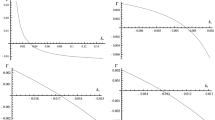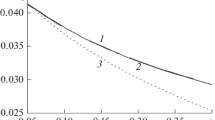Abstract
The studied region is a part of the current circuit of a magnetic loop in a solar active region in the altitude range of 1400–2500 km above the photosphere. At the earliest stage of development of a flare process, the magnetic field of the loop was assumed to be stationary and uniform in the interval corresponding to weak fields (the so-called deca-hectogauss fields). The conditions for emergence and development of instability of the second harmonic of Bernstein modes in this previously unexamined region were determined. This instability (and low-frequency instabilities emerging later) was assumed to be caused by the sub-Dreicer electric field of the loop, while pair Coulomb collisions were considered to be the major factor hindering its development. The obtained extremely low instability thresholds point to the possibility of subsequent emergence of low-frequency instabilities (and plasma waves corresponding to them) with much higher threshold values against the background of saturated Bernstein turbulence. The frequency of electron scattering by turbulence pulsations in this scenario normally exceeds the frequency of pair Coulomb (primarily ion–electron) collisions. Both the quasistatic sub-Dreicer field in the loop and the weak spatial inhomogeneity of plasma temperature and density were taken into account in the process of derivation and analysis of the dispersion relation for low-frequency waves. It was demonstrated that the solutions of the obtained dispersion relation in the cases of prevalent pair Coulomb collisions and dominant electron momentum losses at pulsations of saturated Bernstein turbulence are morphologically similar and differ only in the boundary values of perturbation parameters. In both cases, these solutions correspond to the two wave families, namely, kinetic Alfven waves and kinetic ion acoustic waves. These waves have their own electric fields and may play the important role in the process of preflare acceleration of energetic electrons.
Similar content being viewed by others
References
A. F. Aleksandrov, L. S. Bogdankevich, and A. A. Rukhadze, Principles of Plasma Electrodynamics (Vysshaya Shkola, Moscow, 1989) [in Russian].
H. Bateman, MHD Instabilities (MIT Press, Cambridge, 1978; Energoizdat, Moscow, 1982).
A. A. Galeev, D. G. Lominadze, A. D. Pataraya, et al., “Anomalous plasma resistance due to instability at cyclotron harmonics,” JETP Lett. 15, 294–296 (1972).
A. A. Galeev and R. Sagdeev, “Nonlinear plasma theory,” in Reviews of Plasma Physics, Ed. by M. A. Leontovich (Energoatomizdat, Moscow, 1973; Consultants Bureau, New York, 1979), Vol. 7.
S. I. Gopasyuk, “Structure and dynamics of the magnetic field in active regions on the Sun,” Itogi Nauki Tekh., Ser.: Astron. 34, 7–77 (1987).
C. de Jager, Structure and Dynamics of the Solar Atmosphere (Springer-Verlag, Berlin, 1959; Inostrannaya Literatura, Moscow, 1962).
A. G. Zagorodnii and O. K. Cheremnykh, Introduction to Plasma Physics (Naukova Dumka, Kyiv, 2014) [in Russian].
V. V. Zaitsev, A. V. Stepanov, and Yu. T. Tsap, “On the problems of physics of solar and stellar flares,” Kinematika Fiz. Nebesnykh Tel 10 (6), 3–31 (1994).
B. B. Kadomtsev, Collective Phenomena in Plasmas (Nauka, Moscow, 1988) [in Russian].
B. B. Kadomtsev and O. P. Pogutse, “Turbulence in toroidal systems,” in Reviews of Plasma Physics, Ed. by M. A. Leontovich (Energoatomizdat, Moscow, 1967; Springer-Verlag, New York, 1995), Vol. 5, pp. 249–400.
A. N. Krishtal’, “Low-frequency instabilities of plasma waves in a magnetized collisional plasma with longitudinal electric field and density inhomogeneity,” Radiofiz. Radioastron. 8 (1), 5–20 (2003).
A. N. Kryshtal, A. D. Voitsekhovska, S. V. Gerasimenko, and M. V. Sidorenko, “On the possibility of the development of longitudinal wave instabilities on the background of the small-scale Bernstein turbulence in preflare chromosphere of a solar active region,” Kinematics Phys. Celestial Bodies 30, 234–243 (2014).
A. N. Krishtal’, and S. V. Gerasimenko, “Dispersion of the waves in magnetoactive plasma with sub-Dreicer electric field and strong density inhomogeneity in arch structures,” Kinematika Fiz. Nebesnykh Tel 18, 258–272 (2002).
A. N. Kryshtal, S. V. Gerasimenko, A. D. Voitsekhovska, and O. K. Cheremnykh, “One type of three-wave interaction of low-frequency waves in magnetoactive plasma of the solar atmosphere,” Kinematics Phys. Celestial Bodies 30, 147–154 (2014).
A. B. Mikhailovskii, “Oscillations of an inhomogenous plasma,” in Reviews of Plasma Physics, Ed. by M. A. Leontovich (Energoatomizdat, Moscow, 1963; Springer-Verlag, New York, 1967), Vol. 3, pp. 159–227.
A. B. Mikhailovskii, Theory of Plasma Instabilities, Vol. 2: Instabilities of an Inhomogeneous Plasma (Atomizdat, Moscow, 1975; Springer-Verlag, New York, 2013).
A. P. Mishina and I. V. Proskuryakov, Higher Algebra: Linear Algebra, Polynomials, General Algebra (GIFML, Moscow, 1962; Pergamon, Oxford, 1965).
Basic Plasma Physics, Ed. by A. A. Galeev and R. Sudan (Energoatomizdat, Moscow, 1983), Vol. 1 [in Russian].
Basic Plasma Physics, Ed. by A. A. Galeev and R. Sudan (Energoatomizdat, Moscow, 1984), Vol. 2 [in Russian].
A. I. Podgornyi and I. M. Podgornyi, “Numerical simulation of a solar flare produced by the emergence of new magnetic flux,” Astron. Rep. 45, 60–66 (2001).
E. R. Priest, Solar Magnetohydrodynamics (Springer-Verlag, Dordrecht, 1982; Mir, Moscow, 1985).
B. P. Filippov, Eruptive Processes on the Sun (Fizmatlit, Moscow, 2007) [in Russian].
F. Chen, Introduction to Plasma Physics (Springer, New York, 1974; Mir, Moscow, 1987).
G. P. Chernov, V. V. Fomichev, and R. A. Sych, “New results of studies of zebra structure in solar radio emission,” in Proc. 11th Conf. Plasma Physics in the Solar System, Moscow, Feb. 15–19, 2016 (Inst. Kosm. Issl. Ross. Akad. Nauk., Moscow, 2016), p. 24.
A. N. Shabalin and Yu. E. Charikov, “Generation of hard x-ray radiation by accelerated electrons in the turbulent plasma of solar flares,” in Proc. 11th Conf. Plasma Physics in the Solar System, Moscow, Feb. 15–19, 2016 (Inst. Kosm. Issl. Ross. Akad. Nauk., Moscow, 2016), p. 25.
T. Anan, R. Casini, and K. Ichimoto, “Diagnosis of magnetic and electric fields of chromospheric jets through spectropolarimetric observations of H I Paschen lines,” Astrophys. J. 786, 94 (2014).
M. J. Aschwanden, “An evaluation of coronal heating models for active regions based on Yohkoh, SOHO, and TRACE observations,” Astrophys. J. 560, 1035–1043 (2001).
M. J. Aschwanden, Physics of the Solar Corona. An Introduction with Problems and Solutions, 2nd ed. (Praxis, Chichester, 2005).
M. L. Bendict, A. Shanmugaraju, and B. Vrsnak, “Investigation of X-class flare-associated coronal mass ejections with and without DH Type II radio bursts,” Sol. Phys. 290, 3365–3377 (2015).
S. G. Benka, “DC-electric fields in solar flares; Theory meets observation,” in Proc. Kofu Symp.: New Look at the Sun with Emphasis on Advanced Observations of Corona Dynamics and Flares, Kofu, Sept. 6–10, 1993, Ed. by S. Enome and T. Hirayama, (Nobeyama Radio Observatory, Minamisaku, 1994), pp. 225–229.
R. Casini and E. Landi Degl’Innocenti, “The polarized spectrum of hydrogen in the presence of electric and magnetic fields,” Astron. Astrophys. 276, 289–302 (1993).
J. M. Fontenla, E. H. Avrett, and R. Loeser, “Energy balance in the solar transition region. III — Helium emission in hydrostatic, constant-abundance models with diffusion,” Astrophys. J. 406, 319–345 (1993).
P. Foukal, and S. Hinata, “Electric fields in the solar atmosphere: A review,” Sol. Phys. 132, 307–334 (1991).
A. A. Galeev, D. G. Lominadze, A. D. Pataraya, et al., “Anomalous plasma resistance due to instability at cyclotron harmonics,” JETP Lett. 15, 294–296 (1972).
L. K. Harra, S. A. Matthews, and J. L. Culhane, “Nonthermal velocity evolution in the precursor phase of a solar flare,” Astrophys. J. Lett. 549, L245–L248 (2001).
A. Hasegawa, and L. Chen, “Parametric decay of "kinetic Alfven wave” and its application to plasma heating,” Phys. Rev. Lett. 36, 1362–1365 (1976).
H. S. Hudson, “Chromospheric Flares,” in The Physics of Chromospheric Plasmas: Proc. Coimbra Solar Physics Meeting, Coimbra, Portugal, Oct. 9–13, 2006, Ed. by P. Heinzel, I. Dorotovic, and R. J. Rutten. (Astron. Soc. Pac.,2007), in Ser.: ASP Conference Series, Vol. 368, pp. 365–386 (2007).
L. K. Kashapova, N. S. Meshalkina, and M. S. Kisil, “Detection of acceleration processes during the initial phase of the 12 June 2010 flare,” Sol. Phys. 280, 525–535 (2012).
A. N. Kryshtal, “Low-frequency wave instabilities in a plasma with a quasistatic electric field and weak spatial inhomogeneity,” J. Plasma Phys. 68, 137–148 (2002).
A. N. Kryshtal, “Low-frequency wave instabilities in magnetoactive plasma with spatial inhomogeneity of temperature,” J. Plasma Phys. 71, 729–745 (2005).
A. N. Kryshtal, V. Fedun, S. V. Gerasimenko, and A. D. Voitsekhovska, “Oblique Bernstein mode generation near the upper-hybrid frequency in solar pre-flare plasmas,” Sol. Phys. 290, 3331–3341 (2015).
A. N. Kryshtal and S. V. Gerasimenko, “Kinetic Alfven waves in preflare plasma,” Astron. Nachr. 326, 52–60 (2005).
A. N. Kryshtal, S. V. Gerasimenko, and A. D. Voitsekhovska, “"Oblique” Bernstein modes in solar preflare plasma: Generation of second harmonics,” Adv. Space Res. 49, 791–796 (2012).
A. Kryshtal, S. Gerasimenko, and A. Voitsekhovska, “Small-scale Langmuir wave instability in preflare chromosphere of solar active region,” Astrophys. Space Sci. 349, 637–646 (2014).
A. Kryshtal, S. Gerasimenko, A. Voitsekhovska, and V. Fedun, “The ion-acoustic instability in the pre-flare plasma near the loop footpoints at solar active regions,” Ann. Geophys. 31, 2193–2200 (2013).
M. E. Machado, E. H. Avrett, J. E. Vernazza, and R. W. Noyes, “Semiempirical models of chromospheric flare regions,” Astrophys. J. 242, 336–351 (1980).
I. A. Miller, P. I. Cargil, A. G. Emslie, et al., “Critical issues for understanding particle acceleration in impulsive solar flares,” J. Geophys. Res.: Space Phys. 102, 14631–14659 (1997).
E. I. Schmahl, D. K. Webb, B. Woodgate, et al., “Coronal manifestations of preflare activity,” in Energetic Phenomena on the Sun, Ed. by M. Kundu and B. Woodgate (NASA, Washington, DC, 1986), pp. 1–48–1-79.
S. K. Solanki, “Small-scale solar magnetic fields: An overview,” Space Sci. Rev. 63, 1–188 (1993).
J. E. Vernazza, E. H. Avrett, and R. Loeser, “Structure of the solar chromosphere. III. Models of the EUV brightness components of the quiet-sun,” Astrophys. J., Suppl. Ser. 45, 635–725 (1981).
A. J. Willes and P. A. Robinson, “Electron-cyclotron maser theory for noninteger ratio emission frequencies in solar microwave spike bursts,” Astrophys. J. 467, 465–472 (1996).
V. V. Zharkova, L. K. Kashapova, S. N. Chornogor, and O. V. Andrienko, “The effect of energetic particle beams on the chromospheric emission of the 2004 July 25 flare,” Mon. Not. R. Astron. Soc. 411, 1562–1574 (2011).
Author information
Authors and Affiliations
Corresponding author
Additional information
Original Russian Text © A.N. Kryshtal, A.D. Voitsekhovska, S.V. Gerasimenko, O.K. Cheremnykh, 2017, published in Kinematika i Fizika Nebesnykh Tel, 2017, Vol. 33, No. 4, pp. 3–28.
About this article
Cite this article
Kryshtal, A.N., Voitsekhovska, A.D., Gerasimenko, S.V. et al. Effect of small-scale bernstein turbulence on low-frequency plasma waves in the preflare solar chromosphere. Kinemat. Phys. Celest. Bodies 33, 149–165 (2017). https://doi.org/10.3103/S0884591317040031
Received:
Published:
Issue Date:
DOI: https://doi.org/10.3103/S0884591317040031




